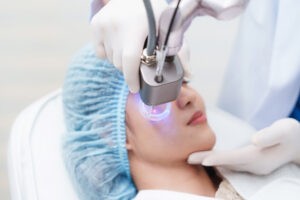Laser treatments have revolutionized dermatology, offering effective solutions for various skin conditions such as acne scars, wrinkles, and sun damage. However, with several laser types available, it is crucial to understand the unique benefits and drawbacks of each. This article explores the comparative efficacy of Fractional CO2, Non-Ablative, and Hybrid lasers, focusing on their impact on specific skin conditions and recovery durations.
Overview of Laser Types
- Fractional CO2 Lasers: Widely regarded for their ability to treat deeper skin layers, Fractional CO2 lasers are known for delivering targeted energy into the skin, creating micro-thermal zones that stimulate collagen production. These lasers are highly effective in addressing more severe skin conditions such as deep acne scars and prominent wrinkles.
- Non-Ablative Lasers: Non-Ablative lasers are a gentler alternative, focusing on stimulating collagen production in the deeper layers of the skin without damaging the surface. They are commonly used for minor wrinkles and superficial sun damage, making them ideal for patients looking for a less invasive option with minimal downtime.
- Hybrid Lasers: As the name suggests, Hybrid lasers combine the benefits of both ablative and non-ablative techniques. This hybrid approach allows for comprehensive skin rejuvenation, targeting both the superficial and deeper layers of the skin. They offer a balanced solution for conditions like mild to moderate wrinkles and sun damage.
Comparative Data Analysis
Based on existing studies and meta-analyses, we compared the three laser types in terms of their improvement percentages for treating acne scars, wrinkles, and sun damage, as well as their recovery durations. The graph below provides a visual representation of the effectiveness of each laser type.

Data Visualization
The graph illustrates the following findings:
- Acne Scar Improvement: Hybrid lasers demonstrated the highest efficacy, showing an 80% improvement, followed closely by Fractional CO2 lasers at 75%. Non-Ablative lasers, while effective, showed a comparatively lower improvement rate of 60%. This suggests that deeper-reaching techniques like Hybrid and Fractional CO2 are more suitable for severe acne scarring.
- Wrinkle Reduction: Hybrid lasers once again displayed superior results, with a 78% reduction in wrinkles. Fractional CO2 lasers showed a 70% improvement, while Non-Ablative lasers trailed at 65%. This trend highlights the effectiveness of combining ablative and non-ablative techniques for comprehensive wrinkle reduction.
- Sun Damage Reduction: When it comes to sun damage, Hybrid lasers achieved an 88% reduction, followed by Fractional CO2 at 85%, and Non-Ablative lasers at 72%. The deeper penetration of Hybrid and Fractional CO2 lasers enables better treatment of sun-damaged skin.
Recovery Duration
One of the primary concerns for patients undergoing laser treatments is the recovery time. The graph indicates the following recovery durations for each laser type:
- Fractional CO2 Lasers: Average recovery time of 14 days.
- Non-Ablative Lasers: Significantly shorter recovery time of 5 days.
- Hybrid Lasers: A moderate recovery duration of 10 days.
These recovery times align with the invasiveness of each laser type. Fractional CO2 lasers, while highly effective, require more downtime due to the deeper tissue damage. Non-Ablative lasers offer the shortest recovery, making them an appealing choice for those seeking a quick recovery with mild skin concerns.
Conclusion
Choosing the right laser treatment depends on the severity of the skin condition and the patient’s tolerance for downtime. Fractional CO2 and Hybrid lasers stand out in terms of efficacy, especially for severe acne scars and sun damage. However, Non-Ablative lasers provide a gentler approach with shorter recovery durations, making them ideal for those with mild concerns or limited downtime availability.
As laser technology continues to evolve, understanding the unique benefits and trade-offs of each type will empower patients and dermatologists to make informed decisions about their treatment plans. By leveraging advancements in these technologies, the field of dermatology is poised to continue delivering enhanced outcomes for patients seeking skin rejuvenation.
Graph Source:
Graph created in collaboration between Nuveau and local Houston SEO agency Round Two Media based on research data based on data from the meta-analysis on the Efficacy of Fractional CO2 and Hybrid Lasers in Acne Scar Treatment, published by Dermatology Times.


